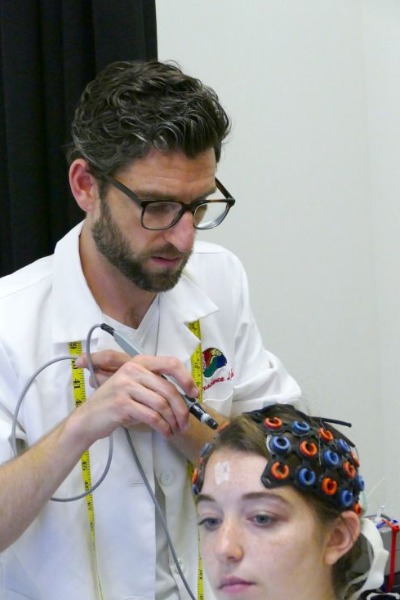Ph.D. student wins NIH's "F31" fellowship



Adam Stone, a fourth-year student in Gallaudet University's Ph.D. in Educational Neuroscience Program, has been awarded a National Institutes of Health National Research Service Award predoctoral fellowship.
NIH logoStone is the second PEN student to receive this prestigious award, often referred to as the F31, from the Eunice Kennedy Shriver National Institute for Child Health and Human Development. Fourth-year student Geo Kartheiser received the award in 2014.
Both students are advisees of renowned cognitive neuroscientist Dr. Laura-Ann Petitto, PEN co-founder and steering committee chair and co-PI of the National Science Foundation and Gallaudet University Science of Learning Center, Visual Language and Visual Learning, VL2.
Adam Stone doing fNIRS training in BL2 "We are very proud of Adam for this wonderful achievement! This award is significant recognition of the superior training Adam is receiving at Gallaudet University and the training that he is receiving in my neuroscience laboratory. It is a testament to the success of our PhD in Educational Neuroscience program and the work we are doing to prepare the next generation of scientists," said Petitto, Scientific Director of the Brain and Language Laboratory for Neuroimaging. "It is especially wonderful affirmation that Gallaudet University is a top-tier site for significant, impactful science and brain research."
The fellowship, established in honor of the first woman director of an NIH institute, is designed to foster mentored research training in health-related fields and to promote diversity in the scientific community.
The exceptional training Stone received from Dr. Petitto in her Brain and Language Laboratory for Neuroimaging, BL2, on infant functional near infrared spectroscopy (fNIRS) neuroimaging and eye tracking methodologies, as well as academic guidance in the PEN program that Dr. Petitto co-founded, were critical to winning the award, Stone said.
"NIH strongly values the training potential of the candidate's scientific environment, particularly his/her adviser and laboratory, when assessing a F31 NRSA application," Stone said. "This award is further evidence that Dr. Petitto provides world-class training and education in the neurosciences. I am quite lucky to have benefited from her training and the exciting scientific environment in her laboratory at Gallaudet University over the past three years."
Stone's dissertation research project explores how all infants discover the building blocks of language by using fNIRS neuroimaging and eye tracking to assess deaf and hearing infants' sensitivity to rhythmic-temporal properties present in all languages, signed and spoken.
"The real innovation of this research is that we can measure the neural tissue and systems in the human brain that enables infants to begin learning their native language," Stone said. "This is the first study ever to use sign language and visual stimuli to answer this question. All past infant neuroimaging studies have used spoken language or sounds, which only reveals part of the complete picture. This study will fill in the rest, giving us powerful new brain-based knowledge about language acquisition in all babies."
Stone, who is also a fellow in the Society for Neuroscience's Neuroscience Scholars Program, said Dr. Petitto's advisorship and his research assistantship in BL2 provides him with an ideal environment for conducting this research.
Research reported in this story was supported by the Eunice Kennedy Shriver National Institute of Child Health and Human Development (NICHD) of the National Institutes of Health under Award Number F31HD087085 (Stone, PI) and the W. M. Keck Foundation (Petitto, PI). The content is solely the responsibility of the authors and does not necessarily represent the official views of the National Institutes of Health or the W. M. Keck Foundation.